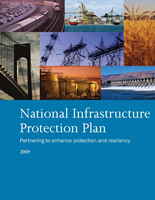2009 National Infrastructure Protection Plan Released

The homeland security risks facing our nation are a complex mix of manmade and naturally occurring hazards, including terrorist attacks, accidents, natural disasters, and other emergencies. National priorities for critical infrastructure and key resources protection include both preventing catastrophic loss of life associated with these risks and minimizing their cascading, disruptive impacts on the U.S. and global economy. Achieving these priorities requires a strategy that appropriately balances building resiliency capabilities with risk-informed prevention and protection activities.
The National Infrastructure Protection Plan (NIPP) describes the nation’s approach to establishing goals, requirements, and performance measures for infrastructure protection and resiliency efforts. The NIPP also sets forth a comprehensive risk management framework. It clearly defines the roles and responsibilities for the Department of Homeland Security, Federal Sector Specific Agencies, and other federal, state, local, tribal, territorial, and private sector partners within the critical infrastructure and key resources mission area.
The just-released 2009 version of the NIPP captures the evolution and maturation of the processes and programs first outlined in 2006. It was developed collaboratively with critical infrastructure and key resources partners at all levels of government and the private sector. The revised NIPP integrates the concepts of resiliency and protection and broadens the focus of NIPP-related programs and activities to an all-hazards environment.
A major accomplishment of the NIPP is the role it has played in building public-private partnerships. It has facilitated closer cooperation between government and industry across the 18 critical infrastructure and key resources sectors. For example, as the Chemical Sector Specific Agency, the Department partnered with the Chemical Sector Coordinating Council to develop the voluntary Web-based Chemical Security Awareness Training Program based on a need identified within the sector.
Several companies beta tested the training program, and the feedback was incorporated into the final product, which was designed not only for those directly involved in security, but for all facility employees. This partnership effort resulted in a free interactive tool available to chemical facilities nationwide to increase security awareness. The training was launched in July 2008 and as of Feb 24, 2009, 929 people had completed it at 277 companies. This pattern of collaboration is essential to strengthening our critical infrastructure and key resources protection and resiliency efforts.
The 2009 revision of the NIPP is available for download from www.dhs.gov/NIPP.
James Snyder
Acting Assistant Secretary for Infrastructure Protection
Labels: infrastructure protection, partnerships, preparedness, private sector

0 Comments:
Post a Comment
Thank you for leaving a comment at the Department of Homeland Security Leadership Journal. Comments submitted to the Department of Homeland Security Leadership Journal will be reviewed before posting.
Create a Link
<< Home